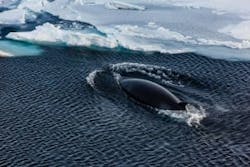Thermal imaging system protects whales from underwater noise pollution
Physicists from the Alfred Wegener Institute (AWI) have developed a system which uses a thermal imaging camera and analysis software to detect whales and subsequently protect them from harmful underwater noise.
Citing pile driving during construction of wind farms and the use of airguns when searching for oil and gas, the report states that Dr. Daniel Zitterbart and his colleagues at AWI wanted to protect whales from such noise pollution by detecting them in the water using a thermal imaging system. In a study published in the journal PLOS ONE, it explains that Zitterbart and his colleagues took the FIRST-Navy infrared camera from Rheinmetall Defence Electronics and converted it into a tool for automatic whale sightings.
FIRST-Navy infrared cameras features 7200 x 576 pixels and can produce 3.5 terabytes of data per day. The images produced by the camera show the sea surface from the vessel at close range (minimum radius of about 120 meters), up to the horizon.
During the past four years, a number of expeditions aboard the Polarstern ship have proved successful.
"The thermal imaging camera is located at 28 meters height in Polarstern’s windy crow’s nest. It is mounted on an active gimbal that compensates the movements of the ship. The imager revolves five times per second and produces a 360-degree video stream of the vessel’s environs, in which warmer regions appear brighter than colder ones,” Zitterbart said.
He continued, “The thermal sensor is so sensitive that it detects differences in temperature of less than a hundredth of a degree Celsius. The whale spout, which, at least in subpolar and polar regions, is significantly warmer than the sea surface, appears as light grey or white fountains on these images.”
Captured video is processed by a software suite that Zitterbart developed himself during his PhD. The software divides each of the record images into 31,600 little snippets which are individually examined for differences in brightness. The computer then decides if any of those snippets show signs of whether the images bear any resemble to the features of a whale spout.
When a whale is detected by the system, appropriate safety measures are implemented, said Dr. Olaf Boebel, head of AWI’s ocean acoustics lab and co-author of the study.
View the press release.
Also check out:
Vision-enabled robot tracks Great Whites for Shark Week special
Crabster robot will explore shipwrecks below the sea
Vision-guided robots will restore coral reefs
Share your vision-related news by contacting James Carroll, Senior Web Editor, Vision Systems Design
To receive news like this in your inbox, click here.
Join our LinkedIn group | Like us on Facebook | Follow us on Twitter | Check us out on Google +
About the Author

James Carroll
Former VSD Editor James Carroll joined the team 2013. Carroll covered machine vision and imaging from numerous angles, including application stories, industry news, market updates, and new products. In addition to writing and editing articles, Carroll managed the Innovators Awards program and webcasts.
